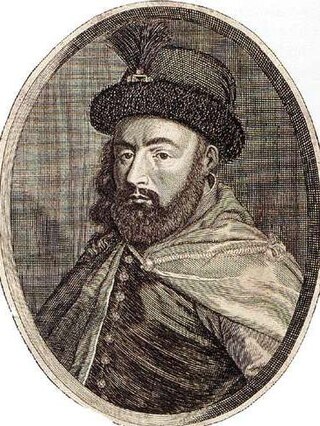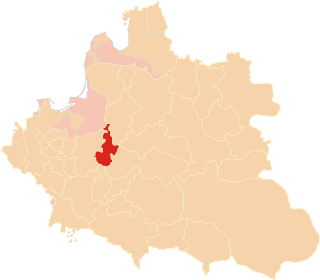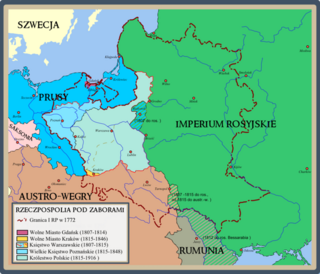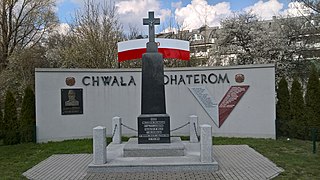Related Research Articles

Drohiczyn is a town in Siemiatycze County, Podlaskie Voivodeship, Poland. The town has a population of 2,110 and is situated on the bank of the Bug River. Drohiczyn has a long and rich history, as in the past it was one of the most important cities of the region of Podlachia. Currently, it is the seat of Roman Catholic Diocese of Drohiczyn.

Podlachia, also known by its Polish name Podlasie, is a historical region in north-eastern Poland. Its largest city is Białystok, whereas the historical capital is Drohiczyn.

The Truce or Treaty of Yam-Zapolsky (Ям-Запольский) or Jam Zapolski, signed on 15 January 1582 between the Polish–Lithuanian Commonwealth and the Tsardom of Russia, was one of the treaties that ended the Livonian War. It followed the successful Livonian campaign of Stephen Báthory, culminating in the siege of Pskov.

Janusz I of Warsaw, also known as Janusz I the Old, was a Polish prince member of the House of Piast in the Masovian branch, from 1373/74 Duke of Warsaw and after the division of the paternal inheritance between him and his brother in 1381, ruler over Nur, Łomża, Liw, Ciechanów, Wyszogród and Zakroczym. In addition, he was a vassal of the Polish Kingdom since 1391 for the fief of Podlachia.

George II Rákóczi, was a Hungarian nobleman, Prince of Transylvania (1648-1660), the eldest son of George I and Zsuzsanna Lorántffy.

Drahichyn is a town in Brest Region, in south-western Belarus. It serves as the administrative center of Drahichyn District. As of 2024, it has a population of 14,804.
Jerzy Nos of Topór was a mediaeval Polish-Lithuanian nobleman. Originally a starost of Drohiczyn and Mielnik, with time he rose to the rank of Prince of Polesia and governor of Pskov. He also held numerous posts in the administration of the Grand Duchy of Lithuania.

The Podlaskie Voivodeship was formed in 1513 by Sigismund I the Old as a voivodeship in the Grand Duchy of Lithuania, from a split off part of the Trakai Voivodeship. After Lithuania's union with the Kingdom of Poland in 1569 and formation of the Polish–Lithuanian Commonwealth, the voivodeship was transferred to the Polish Crown, where it belonged to the Lesser Poland Province of the Polish Crown.

Belostok Oblast was an administrative-territorial unit (oblast) of the Russian Empire with its capital in Belostok (Białystok). The region today is now mostly part of Poland.
Bryki is a village in the administrative district of Gmina Drohiczyn, within Siemiatycze County, Podlaskie Voivodeship, in north-eastern Poland. It lies approximately 10 kilometres (6 mi) north of Drohiczyn, 13 km (8 mi) north-west of Siemiatycze, and 77 km (48 mi) south-west of the regional capital Białystok.
Ostrożany is a village in the administrative district of Gmina Drohiczyn, within Siemiatycze County, Podlaskie Voivodeship, in north-eastern Poland. It lies approximately 13 kilometres (8 mi) north of Drohiczyn, 18 km (11 mi) north-west of Siemiatycze, and 76 km (47 mi) south-west of the regional capital Białystok.
Śledzianów is a village in the administrative district of Gmina Drohiczyn, within Siemiatycze County, Podlaskie Voivodeship, in north-eastern Poland. It lies approximately 13 kilometres (8 mi) north-west of Drohiczyn, 22 km (14 mi) west of Siemiatycze, and 80 km (50 mi) south-west of the regional capital Białystok.
Smarklice is a village in the administrative district of Gmina Drohiczyn, within Siemiatycze County, Podlaskie Voivodeship, in north-eastern Poland. It lies approximately 12 kilometres (7 mi) north of Drohiczyn, 16 km (10 mi) north-west of Siemiatycze, and 77 km (48 mi) south-west of the regional capital Białystok.
Smorczewo is a village in the administrative district of Gmina Drohiczyn, within Siemiatycze County, Podlaskie Voivodeship, in north-eastern Poland. It lies approximately 13 kilometres (8 mi) north of Drohiczyn, 19 km (12 mi) north-west of Siemiatycze, and 76 km (47 mi) south-west of the regional capital Białystok.
Sytki is a village in the administrative district of Gmina Drohiczyn, within Siemiatycze County, Podlaskie Voivodeship, in north-eastern Poland. It lies approximately 6 kilometres (4 mi) north-east of Drohiczyn, 10 km (6 mi) west of Siemiatycze, and 82 km (51 mi) south of the regional capital Białystok.
Wólka Zamkowa is a village in the administrative district of Gmina Drohiczyn, within Siemiatycze County, Podlaskie Voivodeship, in north-eastern Poland. It lies approximately 3 kilometres (2 mi) north-west of Drohiczyn, 17 km (11 mi) west of Siemiatycze, and 87 km (54 mi) south-west of the regional capital Białystok.
Zajęczniki is a village in the administrative district of Gmina Drohiczyn, within Siemiatycze County, Podlaskie Voivodeship, in north-eastern Poland. It is situated on the right bank of the Bug River. The national road No. 62 passes through the village. The village lies approximately 7 kilometres (4 mi) east of Drohiczyn, 9 km (6 mi) west of Siemiatycze, and 85 km (53 mi) south of the regional capital Białystok.

Siemowit I of Masovia, was a Polish prince member of the House of Piast, Duke of Czersk during 1247–1248, Duke of Masovia during 1248–1262, ruler over Sieradz during 1259–1260.

The Battle of Mir took place on 9 and 10 July 1812 during Napoleon's invasion of Russia. Three Polish Lancers divisions battled against Russian cavalry, ending in the first major Russian victory in the war.

The Battle of Białystok was a battle of the Polish–Soviet War that took place near and in Białystok, Poland, on August 22, 1920, between the 1st Legions Infantry Regiment and the remains of the Soviet Russian Red Army 16th Army group and 3rd Army troops in the city of Białystok, which were withdrawing from Warsaw. The confusion caused by the Soviet forces, which had been chased, since their defeat at Warsaw, crushed into the forces stationed in Białystok and caused a complete breakdown in Bolshevik forces.
References
- ↑ Bunar, Piotr; Sroka, Stanisław (1996). Wojny, bitwy i potyczki w średniowiecznej Polsce (in Polish). TAiWPN UNIVERSITAS. p. 42. ISBN 978-83-7052-444-9.
- ↑ Historia Polski. Kalendarium dziejów: Pradzieje-1655, volume 1, red. A. Nowak, Kraków 2010, p. 118. (in Polish)